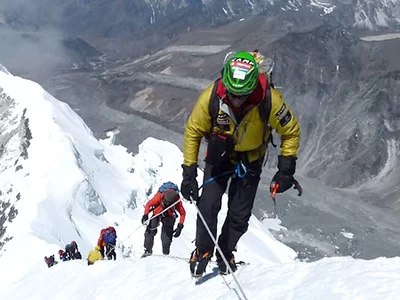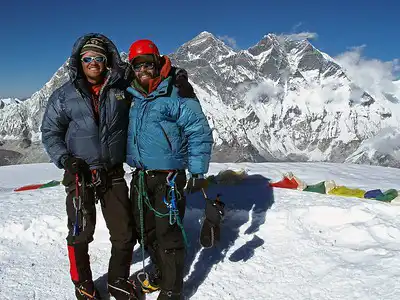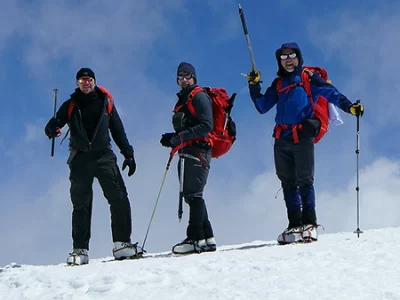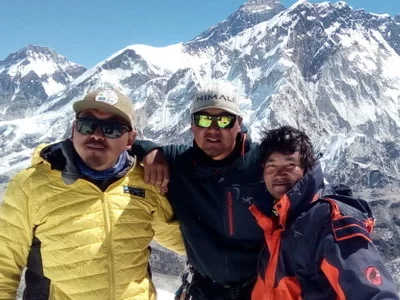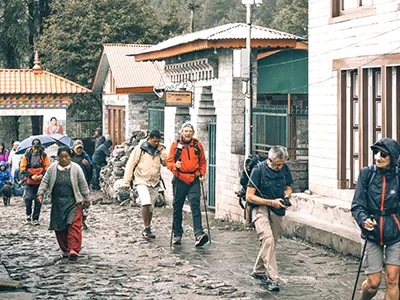Island Peak, also called Imja Tse, is a favored trekking destination in Nepal’s Everest region. Rising to 6,189 meters (20,305 feet), it provides climbers a gateway to high-altitude mountaineering. This peak draws many trekkers with its breathtaking Himalayan views and approachable ascent. However, Island Peak Climbing Difficulty poses significant challenges that climbers should take seriously.
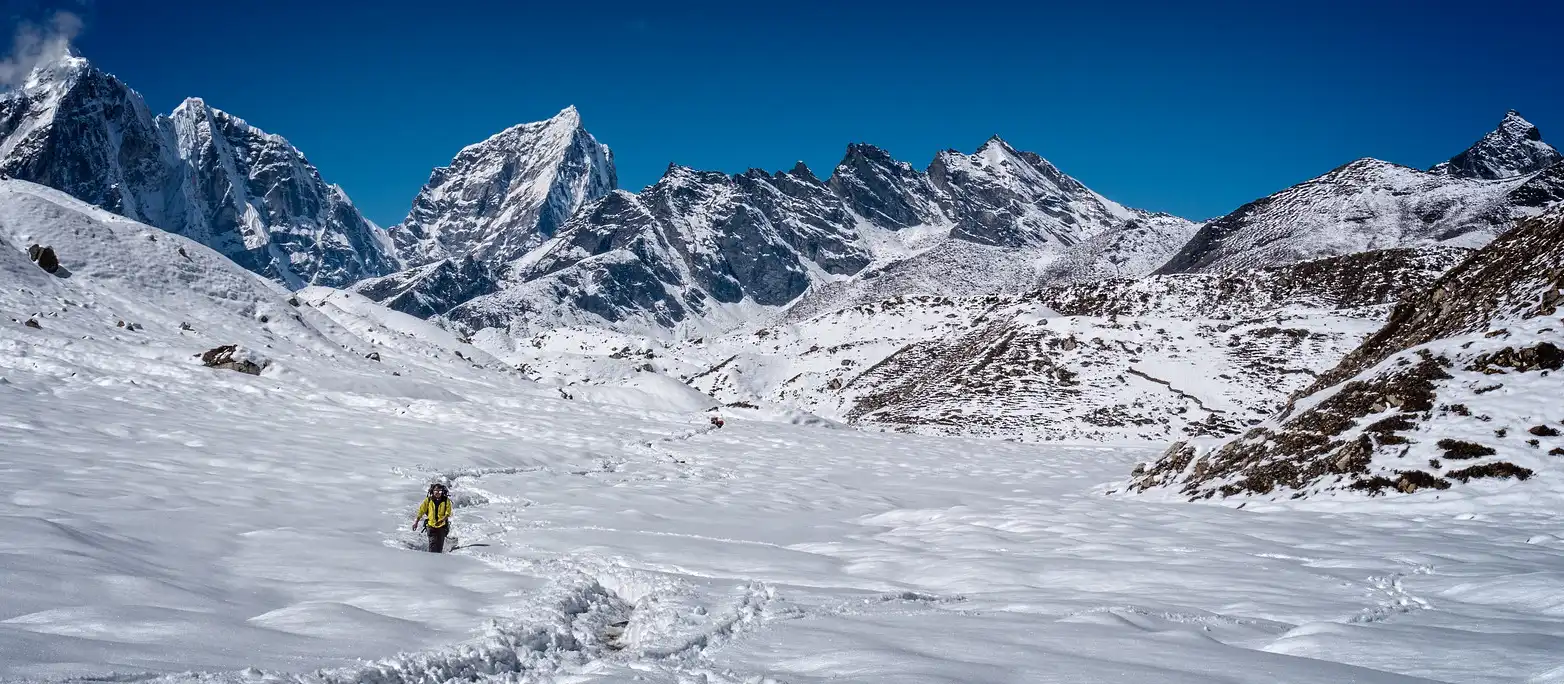
Success at this peak depends on physical endurance, technical climbing skills, and mental preparation. For many climbers, Island Peak is a practice ground for more challenging climbs like Mount Everest.
While often categorized as a trekking peak, Island Peak presents technical sections that may need to catch more experienced climbers off guard. Understanding the involved is essential to making the climbing safe and enjoyable. The peak tests every climber’s readiness from its steep headwalls to the extreme altitude.
Critical Challenges of Island Peak Climbing Difficulty
- High Altitude: One of the significant hurdles climbers face is the altitude. At 6,189 meters, the oxygen levels drop significantly, making breathing harder. Climbers must acclimatize properly to avoid altitude sickness, which can bring symptoms like headaches, nausea, and dizziness. Proper preparation for the Island Peak Altitude is crucial.
- Technical Climbing Sections: Despite being labeled a trekking peak, Island Peak has technical sections that demand mountaineering skills. The final ascent involves crossing glaciers, avoiding crevasses, and using fixed ropes to scale steep headwalls. Knowing how to use crampons and ice axes is essential to navigate these obstacles.
- Steep Ascents and Descents: Both the ascent and descent on Island Peak are steep and challenging. The final summit ridge is narrow and exposed, requiring climbers to stay focused. The descent can be equally demanding, testing climbers’ stamina and attention to detail.
- Unpredictable Weather: Weather conditions play a significant role in the Island Peak Climb. Sudden snowstorms, high winds, and freezing temperatures can complicate the climb. Climbing during the right Island Peak Climbing Season is vital for safety, as it minimizes weather-related risks.
- Physical Endurance: The trek to Island Peak and the climb require muscular physical endurance. Trekkers face long days through rugged terrain, and the climb tests even the fittest climbers with its combination of high altitude and physical demands.
Island Peak Climbing with EBC Trek
Ama Dablam Expedition
Mera Peak Climbing
Physical Fitness and Technical Skills Required for Island Peak Climbing Difficulty
Climbing Island Peak requires both physical endurance and technical expertise. While it is one of the more accessible trekking peaks in the Everest region, the Island Peak Climbing Difficulty demands preparation. To succeed, climbers must meet moderate to high fitness levels and develop specific mountaineering skills. Here, we will break down the fitness and skills required to conquer Island Peak safely.
Fitness Level Needed for Island Peak Climbing
The Island Peak Climb requires excellent physical condition. Since the trek involves multiple days of trekking at high altitudes, climbers need to build endurance. Cardiovascular strength is essential to handle the long hours of trekking and the final ascent, which is physically demanding.
- Moderate to High Physical Fitness: Climbers must maintain fitness to walk 5-7 hours daily on rugged, uneven terrain. High altitudes are associated with low oxygen levels, which may strain your body. In contrast, long-distance trekking or jogging enhances our resistance to these situations since they are endurance training exercises vital for survival in such places. If you would like to carry items along the mountain trail and even climb up very steep areas (as there will be such situations), integrating some strength workouts into your fitness program will be essential.
- Acclimatization: Acclimatizing to the Island’s Peak Altitude is critical for reducing the risk of altitude sickness. The air is much thinner at 6,189 meters (20,305 feet), making breathing more difficult. Climbers should plan their ascent with rest days to adjust to the high altitude.
Basic Mountaineering Skills Required
Although Island Peak is considered a trekking peak, several sections require technical climbing. These skills go beyond standard trekking and require mountaineering experience. Without these abilities, tackling Island Peak Climbing Difficulty can become dangerous.
- Using Crampons and Ice Axes: Climbers must know how to use crampons and ice axes to cross the icy sections of the climb. The final part of the ascent involves a steep glacier, and proper use of these tools ensures safe movement over ice and snow.
- Rope Management: Fixed ropes are often in place during the final ascent, especially when navigating the headwall near the summit. To scale this section, climbers must understand how to use ascenders and safely clip into the ropes. Training in rope techniques is vital for maintaining safety during this part of the Island Peak Climb.
- Crevasse Navigation: Crevasses are standard on the glacier, making it necessary to practice crevasse rescue techniques. Climbers should familiarize themselves with these methods before attempting Island Peak.
Preparation and Training for Success
Adequate preparation is critical to handling Island Peak Climbing Difficulty. The preparation involves a combination of physical training and technical practice.
- Endurance Training: To prepare for the trek to Island Peak, climbers should focus on building endurance. The training often involves long hikes, running, and cycling to improve cardiovascular fitness. Incorporating hill climbing or stair workouts into the routine will also help simulate the steep inclines experienced during the climb.
- Strength Training: Strength training is equally essential, mainly focusing on the legs, core, and upper body. Climbing involves carrying gear and pulling oneself up steep sections, so developing these muscle groups will ease the physical strain.
- Technical Skill Practice: Even if you have good physical fitness, practicing mountaineering skills is necessary. Training with crampons, ice axes, and ropes is essential to get comfortable with these tools before tackling Island Peak. Attending an introductory mountaineering course or practicing on smaller peaks can help improve your skills.
Island Peak Altitude and Its Impact on Climbing
Island Peak, which stands at 6,189 meters (20,305 feet), is a well-known trekking peak in the Himalayas. Its significant altitude makes it a rewarding challenge for climbers looking to test their skills at high elevations. However, Island Peak Climbing Difficulty increases significantly due to the high altitude, where oxygen levels decrease, and the air becomes thinner. These conditions introduce unique challenges that climbers must address to ensure a safe ascent.
Challenges of High-Altitude Climbing on Island Peak
The Island Peak Altitude presents specific obstacles for climbers. As you climb higher, the oxygen in the air decreases, making it harder to breathe. This decrease in oxygen leads to fatigue, shortness of breath, and difficulty maintaining energy levels during the ascent. Climbers often feel these effects more strongly above 3,500 meters, with the challenge intensifying as they approach the summit.
- Thin Air: At altitudes above 6,000 meters, the air becomes so thin that climbers struggle to maintain a steady pace. Physical exertion feels far more taxing with reduced oxygen intake than at lower altitudes. Climbers must slow down and take deliberate steps, increasing the Island Peak Climb’s physical and mental demands.
- Altitude Sickness Risks: One of the significant dangers at such high altitudes is altitude sickness, also known as Acute Mountain Sickness (AMS). Symptoms include headaches, nausea, dizziness, and shortness of breath. In extreme cases, altitude sickness can develop into life-threatening conditions like high-altitude pulmonary edema (HAPE) or high-altitude cerebral edema (HACE). Recognizing and addressing these symptoms early on is crucial to avoiding serious health risks.
Importance of Acclimatization in Reducing Island Peak Climbing Difficulty
Acclimatization plays a vital role in reducing the risks of Island Peak Altitude. Proper acclimatization helps your body adjust to lower oxygen levels, decreasing the chances of altitude sickness and improving your ability to meet the physical demands of high-altitude climbing.
- Gradual Ascent: Climbers should plan for a gradual ascent to help their bodies adapt. Most successful expeditions include multiple acclimatization days, particularly after reaching altitudes above 3,500 meters. A gradual ascent encourages the body to produce more red blood cells, which improves oxygen delivery and helps the body function more effectively in high-altitude environments.
- Rest Days: Incorporating rest days into your climbing schedule also supports acclimatization. These days, you stay at the same altitude or descend slightly before ascending again. This recovery period allows your body to adjust to the thin air without becoming overwhelmed. Moving slowly and steadily helps manage the Island’s Peak Climbing Difficulty.
Tips to Prepare for Altitude Challenges on Island Peak
Adequate preparation is essential for overcoming the challenges posed by Island Peak Altitude. The following tips will help you prepare for the altitude challenges you may face during the climb:
- Pre-Climb Training: Concentrate on cardiovascular health during the months leading up to your ascent. Running, hiking, and swimming can improve your endurance and lung volume. These enhancements are of the utmost importance when adapting to the decreasing amounts of oxygen in high places.
- Acclimatization Techniques: Try trekking at high altitudes before attempting Island Peak. If possible, train on peaks reaching 3,500 meters or higher. This adjustment will help your body adapt to thin air conditions and better understand how it reacts to high altitudes. Understanding these reactions allows you to manage symptoms before they worsen.
- Stay Hydrated and Nourished: To maintain good health in a mountainous region, one must sustain oneself through adequate water intake and exemplary dietary practices. Make sure you consume enough fluids as you go up the slope, and also eat foods with high carbohydrate content since they are the main constituents of most energy-providing diets. Staying fit and eating well can help mitigate the effects of living near deep valleys, as you’ll have more stamina and feel refreshed throughout.
- Listen to Your Body: During the Island Peak Climb, paying attention to your body and any signs of altitude sickness is essential. If you experience symptoms like headaches or nausea, slow your pace and notify your guide immediately. If you ignore these signs, more severe conditions may develop, potentially requiring you to descend for treatment.
Lobuche Peak Climbing
Everest Base Camp Trek
Luxury Everest Base Camp Trek
Technical Sections of Island Peak Climbing Difficulty
Although climbers often classify Island Peak as a trekking peak, it presents significant technical challenges. The Climbing Difficulty stems from several demanding sections that require mountaineering skills and proper equipment.
Climbers must cross glaciers, ascend steep headwalls, and tackle exposed ridges, which require careful preparation. Let’s break down the technical challenges of Island Peak to understand better what climbers should expect.
Glacier Traverse on Island Peak
The glacier traverse is one of the significant technical hurdles during the Island Peak Climb. Near the summit, climbers face a vast glacier, where they must navigate icy terrain and cross hidden crevasses. This section can be dangerous if approached without caution. Using crampons and ice axes is crucial for safely moving across the glacier.
- Preparation for Crevasses: Climbers must be ready for the possibility of falling into crevasses. Learning crevasse rescue techniques and understanding how to use safety ropes effectively is vital. During guided climbs, fixed ropes often assist climbers in navigating the glacier safely, reducing the risk of accidents.
The Headwall and Steep Ascents
Another significant challenge is the steep headwall near the summit. This section stands out as one of the most challenging parts of the climb. Ascending the headwall requires fixed ropes and ascenders, making this part of the climb physically and mentally demanding.
- Fixed Ropes: To ascend the headwall, climbers must use fixed ropes for support. Understanding how to clip into these ropes and use an ascender efficiently is essential for success. This section pushes your endurance and technical skills, contributing significantly to the overall Island Peak Climbing Difficulty.
- Steep Ascents: The ascent up the headwall is exhausting, primarily due to the high altitude. The reduced oxygen levels make it challenging to maintain a fast pace, so moving slowly and steadily is essential. Pacing yourself is critical to overcoming this physically challenging section.
The Final Summit Ridge
The final approach to the summit involves crossing a narrow, exposed ridge. This part of the Island Peak Climb tests a climber’s balance and mental strength.
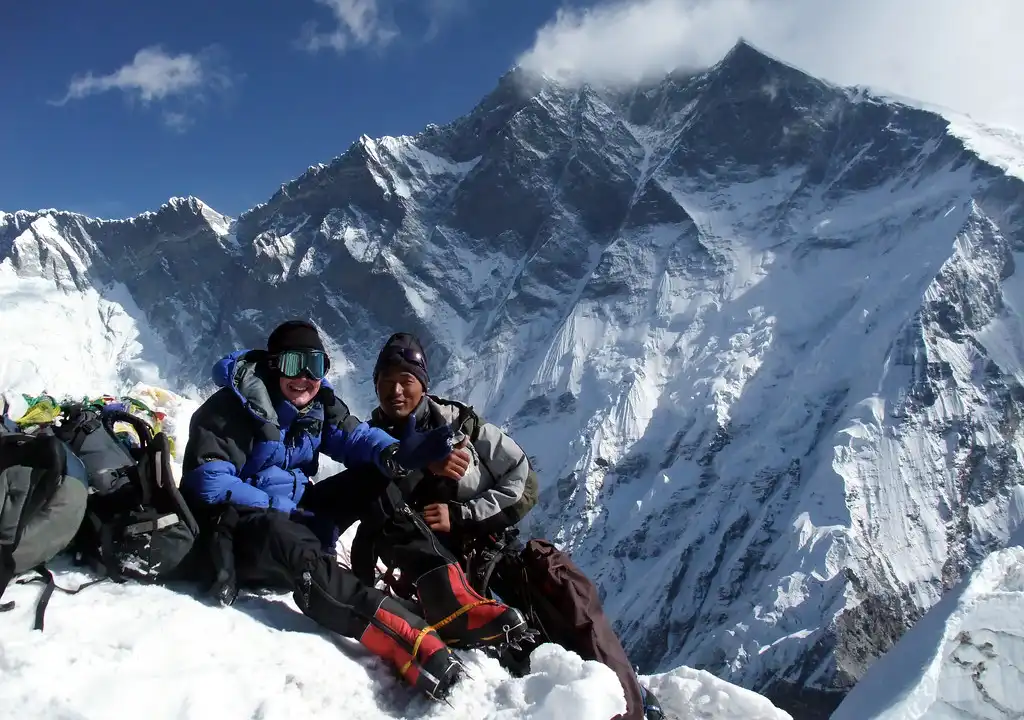
With steep drops on either side of the hill, the exposure and high altitude make this section challenging mentally and physically.
- Balance and Focus: Crossing the summit ridge requires intense concentration, especially in icy conditions or strong winds. Climbers must maintain their balance as they navigate the narrow path, knowing that a misstep could lead to severe consequences.
Ice and Rock Climbing Components
Island Peak involves ice and rock climbing, which adds complexity to the ascent. Climbers must adapt to different types of terrain, from icy surfaces to rocky sections, making it crucial to possess diverse mountaineering skills.
- Ice Climbing: Ice climbing is significant in the ascent, particularly in the glacier and headwall sections. One must use ice axes and crampons on vertical or steep ice to progress on these challenging climbs.
- Rock Climbing: While much of the climb involves ice, there are also rocky sections where climbers need to scramble or use rock-climbing techniques. The varied terrain makes Island Peak more demanding than most trekking peaks, as climbers must switch between different mountaineering skills throughout the climb.
Island Peak Climbing Season and Weather Conditions
The success of climbing Island Peak depends significantly on timing. Due to changing weather conditions, the Island Peak Climbing Season directly affects the difficulty level. Climbers need to understand when to attempt the climb and how different weather factors can influence the overall experience.
Best Seasons for Island Peak Climbing
In the best island peak climbing season, spring (from March to May) is the best time, while autumn falls within the same time (between September and November). These months offer favorable weather for most climbers.
- Spring (March-May): Spring offers stable weather, making it an excellent time for the Island Peak Climb. Temperatures are moderate, and snow is easier to manage. With fewer crowds than in autumn, this season also provides clearer skies for stunning views of the Himalayas.
- Autumn (September-November): Autumn is another popular season for climbing Island Peak. After the monsoon, the weather tends to be clear, offering excellent visibility. Moderate temperatures and stable conditions on the glacier and summit ridge make this season highly preferred by climbers.
Weather Conditions and Their Impact on Island Peak Climbing Difficulty
Weather plays a significant role in shaping the overall difficulty of climbing Island Peak. Climbers should prepare for various weather challenges, including snow, wind, and visibility, which can impact the climb’s difficulty.
- Snow Conditions: Snow levels vary by season. Spring snow is often softer, while autumn typically brings more compact snow that is easier to climb. However, heavy snowfall can cover crevasses, making the climb more dangerous and increasing the risk of falls.
- Wind: Expect strong winds at higher altitudes, particularly near the summit. These winds make it harder to maintain balance and can quickly drop temperatures, increasing the risk of frostbite. Understanding wind patterns and packing the right gear will help ensure safety.
- Visibility: Clear visibility is crucial when navigating the technical parts of Island Peak, such as the glacier traverse and summit ridge. Poor visibility caused by fog or snowstorms can raise the risk of accidents. During the Island Peak Climbing Season, autumn often offers clearer skies, while spring might bring afternoon cloud cover.
Tips for Preparing for Island Peak Weather
Preparation for unpredictable weather is essential when tackling the Island Peak Climb. Below are practical tips to help you manage weather conditions and stay safe:
- Pack the Right Gear: Always pack layers, including insulated jackets, gloves, and hats, to protect yourself from cold and wind. Waterproof and windproof clothing is necessary since the weather at high altitudes changes rapidly.
- Check Weather Forecasts Regularly: Monitor the weather forecast daily. Flexibility is key. Delaying your climb in bad weather can help avoid unnecessary risks and ensure a safer ascent.
- Prepare for Early Mornings: Start climbing early, especially during spring, to avoid afternoon cloud cover. Early starts allow you to complete the most challenging sections under more apparent conditions.
- Practice in Various Conditions: Train for the climb by practicing in snow, wind, and low-visibility environments. This training will help prepare you for the weather challenges you may encounter during your ascent.
Island Peak Climb Duration and Daily Challenges
The Island Peak Climb offers both a rewarding and demanding experience. Success relies heavily on proper planning, especially regarding the duration of the climb and daily physical challenges.
Understanding the Island’s Peak Climbing Difficulty and preparing for the obstacles each day presents will boost your confidence and readiness.
Typical Duration of the Island Peak Climb
The average duration of the Island Peak Climb is about 15-18 days. These days include several acclimatization stops to minimize the risk of altitude sickness. The typical round-trip ascent from base camp to the summit and back takes 2-3 days. The rest of the trip involves trekking through the Khumbu Valley, gradually adjusting to the high Island Peak Altitude of 6,189 meters.
- Trekking to Base Camp (7-10 days): Starting from Lukla, the trek to Island Peak Base Camp passes through well-known stops like Namche Bazaar and Tengboche. Rest days are essential during this period to allow for proper acclimatization. These stops prepare your body for the high altitude, significantly reducing the risk of altitude-related issues.
- Summit Day (1 day): The summit day is the Island Peak Climb’s most complex and rewarding part. Climbers start early, around midnight, and face steep ascents, technical sections, and freezing temperatures. The entire round trip generally takes 10-12 hours.
- Return to Lukla (3-4 days): After summiting, climbers retrace their steps back to Lukla. Although descending is quicker, managing your pace and avoiding overexertion is essential.
Daily Challenges on the Island Peak Climb
Several challenges define the Island Peak Climbing Difficulty, and climbers should expect new obstacles daily. From long trekking hours to dealing with extreme temperatures, every step requires focus and preparation.
- Long Trekking Days: Most trekking days involve 5-7 hours of hiking over rugged terrain with steep ascents and descents. The closer you get to base camp, the more complex each step becomes due to the thinning air. Slowing your pace and conserving energy is critical at these higher altitudes.
- Cold Temperatures: As you ascend, the temperatures drop significantly, particularly during the night and early morning. Summit day often features temperatures that fall below freezing. Wearing layers and insulated clothing is essential to stay warm and prevent hypothermia.
- Energy Management: Managing your energy levels is vital to overcoming the Island Peak Climbing Difficulty. You must pace yourself, take regular breaks, and consume high-energy snacks. Hydration is equally important, as dehydration can occur quickly at high altitudes. Staying focused and maintaining mental endurance is crucial to successfully reaching the summit.
Mental Strength and Motivation in Overcoming Island Peak Climbing Difficulty
Climbing Island Peak requires both physical fitness and mental resilience. The Island Peak Climbing Difficulty presents many physical obstacles, but success often hinges on mental strength.
Climbers must train their minds to cope with fatigue, altitude issues, and harsh environments. Mental resilience and motivation are essential to conquering the challenges of the Island Peak Climb.
Importance of Mental Resilience in Overcoming Physical Difficulties
The Island Peak Climb exposes climbers to high altitudes, freezing temperatures, and long days of effort. While physical training prepares the body, mental resilience helps climbers persevere through the most challenging moments. As oxygen levels decrease with altitude, each step becomes harder. Mental focus and strength become crucial for handling these increasing difficulties.
- Pushing Through Fatigue: Higher altitudes make your body feel more tired due to the reduced oxygen and effort required to move through uneven terrain. Mental resilience keeps you going despite the fatigue. Staying focused on the next step, rather than the overall challenge, allows you to manage the difficulty and push forward. Maintaining a positive attitude and concentrating on reaching the summit is essential.
- Managing Altitude Sickness: The high Island Peak Altitude brings a risk of altitude sickness, which makes the climb even more difficult. Mental strength helps you stay calm, assess your physical condition, and make intelligent decisions about resting or continuing. Resilience allows you to manage discomfort and uncertainty while climbing at high altitudes.
Staying Motivated During Challenging Moments
The Island Peak Climb often brings moments of doubt and frustration. Climbers need to develop mental strategies to stay motivated during these challenging sections.
- Set Small Achievable Goals: Breaking the climb into smaller sections keeps motivation high. Focus on reaching the next rest point, base camp, or a notable landmark. Achieving these smaller goals provides a mental boost and makes the climb feel more manageable.
- Visualize Success: Visualizing the summit can keep you motivated. Picture the breathtaking views from the top and the sense of accomplishment. This positive mindset helps you stay focused, even when your body feels worn out.
- Find Inspiration in the Environment: The beauty of the Himalayas can serve as a source of mental energy. Appreciate the stunning peaks and glaciers around you. Focusing on nature can help shift your perspective and re-energize your mind during challenging moments.
- Support from Fellow Climbers: Encouragement from other climbers makes a big difference. Group motivation creates a sense of teamwork, making it easier to get through challenging sections. Sharing the experience lifts spirits and keeps everyone focused on reaching the summit.
Conclusion: Overcoming Island Peak Climbing Difficulty
Climbers face several physical and mental challenges when attempting Island Peak. The Island Peak Climbing Difficulty comes from high altitudes, technical climbing sections, and challenging terrain. By preparing correctly for these obstacles, climbers can significantly improve their chances of success.
Some primary challenges include dealing with the high Island Peak Altitude, which can cause altitude sickness, and navigating technical sections like glacier traverses. Long days of trekking also lead to fatigue. In addition, unpredictable weather during the Island Peak Climbing Season makes planning the ascent at the right time crucial.
Before attempting the Island Peak Climb, climbers must carefully assess their physical and mental readiness. Engaging in fitness training, acclimatizing to altitude, and building mental resilience will help overcome these challenges.
With the proper preparation and choosing the correct Island Peak Climbing Season, reaching the summit of Island Peak becomes an achievable goal. Climbers can successfully conquer this rewarding climb by focusing on physical endurance, mental strength, and proper acclimatization to the Island Peak Altitude.

